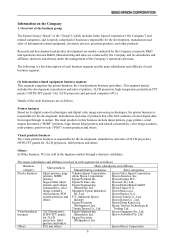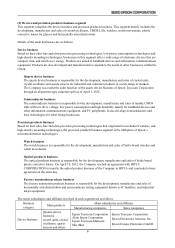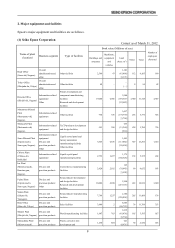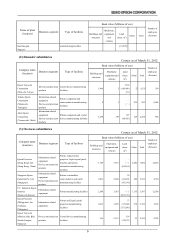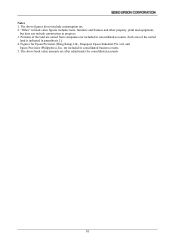Epson 2012 Annual Report Download - page 16
Download and view the complete annual report
Please find page 16 of the 2012 Epson annual report below. You can navigate through the pages in the report by either clicking on the pages listed below, or by using the keyword search tool below to find specific information within the annual report.
15
parties who supply ink cartridges that can be used in Epson printers. These alternative products are sold for less
than genuine Epson ink cartridges and have a higher market share in emerging markets than in developed
economies.
To counteract the loss in market share of genuine ink cartridges, Epson will pursue a policy of realizing customer
value by emphasizing the quality of its genuine products as well as by boosting user-friendliness with inkjet
printers tailored to customer needs in each market, such as models equipped with high-capacity ink tanks. Epson
will also take legal measures if any of the patent rights or trademark rights it holds over its ink cartridges are
infringed.
There is no assurance, however, that any of these efforts will be effective, and if Epson’s net sales from
consumable products for inkjet printers declines because, for example, the market share of non-genuine ink
cartridges increases further or because genuine ink cartridges lose market share or Epson must reduce the prices
of Epson brand products, operating results might adversely be affected.
5. Market changes could affect Epson.
Epson is concentrating management resources on domains in which it can leverage its unique
strengths—printing, projection, devices and precision products—and on future growth areas that will support the
next generation as it seeks to strengthen its business foundations.
However, because technological innovation and product cycles are changing extremely rapidly in markets where
Epson is focusing its managerial resources, the Company may be unable to respond flexibly to such changes and
develop and sell competitive products. In addition, reduced demand and capital expenditure in Epson’s main
markets stemming from economic downturns have hurt demand for Epson’s products in the past and may do so
in the future.
If, for example, Epson cannot suitably respond to technological innovations in its main markets, or if economic
downturns or other factors prevent a recovery in demand, Epson’s operating results could adversely be affected.
6. Epson competes with other companies.
Epson presently faces competition from powerful companies with abundant financial resources or strong
financial compositions and from companies in such countries and regions as Taiwan, Korea, or China that have
the ability to manufacture competitive products or compete on price in Epson’s markets. This competition could
adversely affect Epson’s operating results.
In addition to such competition, there is also the possibility that powerful companies against which Epson does
not currently compete may use their brand power, technological strength, ability to procure funds, marketing
power, sales skills or low-cost production ability to newly enter a business area of Epson’s and compete with it.
7. Expanding businesses overseas entails risks for Epson.
Epson is continuing to expand its businesses overseas; more than 60% of its consolidated sales for the business
year ended March 2012 were overseas sales. Epson has production sites all over Asia, including China, Indonesia,
Singapore, Malaysia and the Philippines, as well as in the United States, the United Kingdom, and other
countries. It has also established many sales companies all over the world. As of March 2012, overseas
employees account for more than 70% of Epson's total workforce.
Epson believes that its global presence provides many advantages. For example, it enables Epson to undertake
marketing activities aligned with the market needs of individual regions and leads to greater
cost-competitiveness by reducing manufacturing costs and lead times. There are, however, unavoidable risks
associated with overseas manufacturing and sales operations. These include but are not limited to changes in
national laws, ordinances, or regulations related to manufacturing and sales; social, political or economic
changes; transport delays; damage to infrastructure (e.g., power supply); currency exchange restrictions;
insufficient skilled labor; changes in regional labor environments; changes in taxes, regulations or the like
protective of trade; and laws, ordinances, regulations, or the like related to the import and export of Epson
products.
8. The intense technological innovation required of Epson entails risks.
Epson is engaged in manufacturing and selling products that require advanced technologies, so technological
superiority is a vital element of Epson’s competitiveness. Epson’s competitive strength is backed by compact,
energy-saving and high-precision technologies that are the source of its core technologies and have produced


